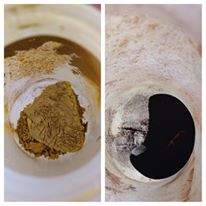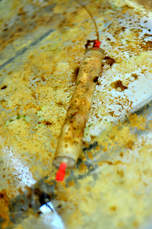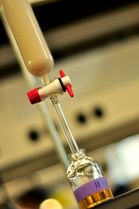|
Characterizing organic-metal ligands along the Mid Atlantic Ridge, 2019-present
Within the ocean, organic-metal binding ligands are an import mechanism for microorganisms to remove toxic metals and gain access to important (micro)nutrients, such as Fe. While there are several sources of Fe to the ocean, hydrothermal vents are emerging as potentially significant and one that is insensitive to changes in climate. Recent geochemical studies have demonstrated multiple potential mechanisms that would allow hydrothermally-derived Fe to be protected and transported within the buoyant and non-buoyant plume. As part of the 2018 FeRidge cruise (@FRidge_GA13), samples for trace metals and organic ligands were collected at or around 11 known venting locations to identify and characterize organic ligands associated with Fe in hydrothermal fluids along the Mid-Atlantic Ridge. The binding strength and concentrations of organic Fe-binding ligands will be quantified using competitive ligand exchange cathodic stripping voltammetry (CLE-ACSV) within the hydrothermal fluids and in the water column in the buoyant plume, and liquid chromatography coupled to inductively coupled plasma mass spectrometry and electron spray ionization mass spectrometry (LC-ICP/ESI-MS) will be used to characterize the sources of organic ligands associated with Fe. This study aims to understand organic complexation in different hydrothermal venting regimes. |
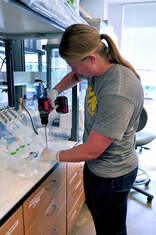 Shelby Gunnells, a 2019 JISAO Summer Intern, prepares the chimney sample for organic extraction. Shelby Gunnells, a 2019 JISAO Summer Intern, prepares the chimney sample for organic extraction.
Characterizing organic-metal binding ligands in an inactive chimney sample from the Lost City Hydrothermal Vent Field, 2019-present
Lost City is a serpentine-hosted hydrothermal vent located along the Mid-Atlantic Ridge. Discovered in 2000, its unique geological setting produces alkaline, organic rich fluids that have potential clues about the origin of life. While rich in organics, Lost City fluids and chimneys are limited in trace metals when compared to black smoker hydrothermal vents. Organic ligands can help stabilize and cycle limited (micro)nutrients important for microbial life. Using a piece of the chimney collected from the Poseidon complex, we aim to identify organics ligands at Lost City. Liquid chromatography coupled to inductively coupled plasma mass spectrometry and electron spray ionization mass spectrometry (LC-ICP/ESI-MS) will be used to characterize the sources of organic ligands associated with trace metals. This study aims to understand the role of organic ligands in cycling trace metals at Lost City hydrothermal vent. |
The stabilization of diffuse flow hydrothermal iron fuels surface ocean primary production, 2018-present
In the ocean, iron (Fe) is an important micronutrient for phytoplankton growth. Phytoplankton play a vital role in the global carbon (C) cycle, accounting for 50% of the total photosynthesis on the planet. When they die, phytoplankton sink and can become buried in the sediments of the deep ocean, removing C from the atmosphere and surface water. While Fe is an abundant element overall in the Earth’s crust, it is extremely diluted in the surface ocean. These Fe-poor surface waters limit phytoplankton growth and their ability to remove C from the atmosphere and surface ocean, especially in areas such as the Southern Ocean where macronutrients are high but surface Fe remains low. These areas are called high nutrient low chlorophyll regions (HNLC), and have the potential to support much more phytoplankton growth if new Fe was available in surface waters. Hydrothermal vents have become a highly debated potential source of new Fe to the surface waters of the Southern Ocean. Previously, it was thought that Fe was precipitated in close proximity to the vent field, due to the high scavenging potential of Fe and the chemistry in the buoyant hydrothermal plume. However, recent geochemical models coupled to in-situ data have indicated a large hydrothermal Fe source in the Southern Pacific Ocean along the East Pacific Rise (EPR) that, if capable of long-range transport, can eventually be upwelled to Southern Ocean surface waters and fuel phytoplankton primary production. Previous studies have hypothesized that two mechanisms, nanoparticles and organic complexation, are likely responsible for transport of hydrothermal Fe over long distances. Yet, this mechanism has not been confirmed. Therefore, hydrothermal fluids could be an unrecognized nutrient source to the surface ocean, and play a critical role in global C cycling. The study will focus on identifying the chemical speciation and the mechanism for the long-range transport of hydrothermal Fe, therefore transforming our paradigm about mid-ocean ridge biogeochemistry.
In the ocean, iron (Fe) is an important micronutrient for phytoplankton growth. Phytoplankton play a vital role in the global carbon (C) cycle, accounting for 50% of the total photosynthesis on the planet. When they die, phytoplankton sink and can become buried in the sediments of the deep ocean, removing C from the atmosphere and surface water. While Fe is an abundant element overall in the Earth’s crust, it is extremely diluted in the surface ocean. These Fe-poor surface waters limit phytoplankton growth and their ability to remove C from the atmosphere and surface ocean, especially in areas such as the Southern Ocean where macronutrients are high but surface Fe remains low. These areas are called high nutrient low chlorophyll regions (HNLC), and have the potential to support much more phytoplankton growth if new Fe was available in surface waters. Hydrothermal vents have become a highly debated potential source of new Fe to the surface waters of the Southern Ocean. Previously, it was thought that Fe was precipitated in close proximity to the vent field, due to the high scavenging potential of Fe and the chemistry in the buoyant hydrothermal plume. However, recent geochemical models coupled to in-situ data have indicated a large hydrothermal Fe source in the Southern Pacific Ocean along the East Pacific Rise (EPR) that, if capable of long-range transport, can eventually be upwelled to Southern Ocean surface waters and fuel phytoplankton primary production. Previous studies have hypothesized that two mechanisms, nanoparticles and organic complexation, are likely responsible for transport of hydrothermal Fe over long distances. Yet, this mechanism has not been confirmed. Therefore, hydrothermal fluids could be an unrecognized nutrient source to the surface ocean, and play a critical role in global C cycling. The study will focus on identifying the chemical speciation and the mechanism for the long-range transport of hydrothermal Fe, therefore transforming our paradigm about mid-ocean ridge biogeochemistry.
Past Projects

Colleen collecting C and Fe data on hydrothermal plume particles at the Advance Light Source in Berkeley, CA. (February 2015)
The mineralogy, geochemical reactivity, and speciation of deep-sea hydrothermal plume particles, 2014-2018
Iron (Fe) is a vital micronutrient to support life in the ocean. Investigating the bioavailability and transport mechanisms of Fe away from the vent axis could aid in understanding the impact of the hydrothermal Fe on life in the deep ocean. As part of the 2013 U.S. GEOTRACES-EPZT cruise, samples were collected along a ~8000 km transect, that includes a 4357 km stretch of hydrothermally influenced waters and sediments. The goal of this study is to investigate how iron (Fe) is protected from sedimentation oxidation processes and transported by marine hydrothermal plumes. I will examine the Fe and carbon speciation at the Scanning Transmission X-ray Microscope (STXM) and X-ray Microprobe at the Advance Light Source in Berkeley, CA. In addition, minerology, Fe flux to the seafloor, and enzyme activity will also be investigated.
See here for publications linked to this project.
Iron (Fe) is a vital micronutrient to support life in the ocean. Investigating the bioavailability and transport mechanisms of Fe away from the vent axis could aid in understanding the impact of the hydrothermal Fe on life in the deep ocean. As part of the 2013 U.S. GEOTRACES-EPZT cruise, samples were collected along a ~8000 km transect, that includes a 4357 km stretch of hydrothermally influenced waters and sediments. The goal of this study is to investigate how iron (Fe) is protected from sedimentation oxidation processes and transported by marine hydrothermal plumes. I will examine the Fe and carbon speciation at the Scanning Transmission X-ray Microscope (STXM) and X-ray Microprobe at the Advance Light Source in Berkeley, CA. In addition, minerology, Fe flux to the seafloor, and enzyme activity will also be investigated.
See here for publications linked to this project.
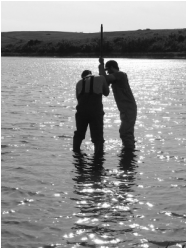
Dr. Bill Arnold and Grant Wallace coring Prairie Pothole Lake P1 in North Dakota (June 2016).
Extracellular enzyme activity in lake and marine sediments: Documenting the effects of sample storage, 2016-2017
Mineral surface properties, including surface area, are considered one of the largest factors in preservation/burial of organic carbon (OC) in both marine and terrestrial sediments. Microorganisms access these OC reserves by producing extracellular (exo) enzymes to gain selective advantage within their specific environment. Exo-enzyme activity is thought to be a critical aspect of global cycling in terrestrial, freshwater, and marine systems. However, incorporation of exo-enzymes into global biogeochemical models is currently limited by several issues including limited understanding of the impact of sorption to mineral surfaces and a lack of data for marine sediments. My goal is to address these two problems by understanding the impacts that sample storage have on the minerology-exo enzyme relationship.
Mineral surface properties, including surface area, are considered one of the largest factors in preservation/burial of organic carbon (OC) in both marine and terrestrial sediments. Microorganisms access these OC reserves by producing extracellular (exo) enzymes to gain selective advantage within their specific environment. Exo-enzyme activity is thought to be a critical aspect of global cycling in terrestrial, freshwater, and marine systems. However, incorporation of exo-enzymes into global biogeochemical models is currently limited by several issues including limited understanding of the impact of sorption to mineral surfaces and a lack of data for marine sediments. My goal is to address these two problems by understanding the impacts that sample storage have on the minerology-exo enzyme relationship.
Understand Fungi and mineral relationships, 2016-2017
The goal of this study was to culture different fungi isolates (mainly from Soudan Mine) and understand their response to certain metals.
The goal of this study was to culture different fungi isolates (mainly from Soudan Mine) and understand their response to certain metals.
|
How Fe mineralogy affects growth of freshwater iron-reducing bacteria, 2013-2016
Geobacter sulfurreducens is a well-studied and representative Fe(III) reducing bacteria in freshwater systems. The objective was to investigate how the redox potential of Fe minerals influences the pathways Geobacter sulfurreducens used in reducing Fe(III). Five different iron oxyhydroxides (FeOOH) were synthesized in order to cover a range of iron mineral potentials. They were then characterized to determine purity, and incubated with Geobacter sulfurreducens. Incubated samples were further investigated by X-ray Diffraction (XRD) and Fe Extended X-ray Absorption Fine Structure (EXAFS) to observe changes in the mineralogy. Click here for publications linked to this project. |
|
Marine microbial induced corrosion patterns monitored in time-series experiment at Santa Catalina Island, California, 2011-2016
The goal of this study is to investigate how iron oxidizing bacteria influence corrosion of mild steel and pyrite in the ocean. A high iron and eutrophic FLow-though Osmotic Colonization System (FLOCS) were deployed on Catalina Island for six months. FLOCS are an osmotically driven continuous flow chamber that are ideal for long deployments, as no battery is needed. Traditionally used in the deep biosphere to study life beneath the ocean floor, our study is the first to use the technology for surface studies. In addition, known flow rates allow us to build a timeline for the length of the deployment. Both biological (DNA, RNA, metagenomics) and chemical (ICP-MS, STXM) studies were conducted on the incubated mineral chips. Additionally, mineral chips were imaged both before and after deployment to investigate morphological changes on the surface. Click here for publications linked to this project. |
Identification of a new bacteria species isolate from the ocean crust, 2012-2013
The goal of this study was characterize Bacillus rigiliprofundis, a recent microorganism isolated from deep subseafloor basaltic crust. We measure its ideal growth temperature, %NaCl, and pH. Additionally, I was responsible for investigating siderophore production in Bacillus rigiliprofundis and three closely related Bacillus spps. These research results are described in more detail in the publication listed here.
The goal of this study was characterize Bacillus rigiliprofundis, a recent microorganism isolated from deep subseafloor basaltic crust. We measure its ideal growth temperature, %NaCl, and pH. Additionally, I was responsible for investigating siderophore production in Bacillus rigiliprofundis and three closely related Bacillus spps. These research results are described in more detail in the publication listed here.
Searching for life in the deep biosphere: sequencing crustal rocks collected in the North Atlantic, 2012-2013
Seventy percent of microbial life on earth is thought to exist below the ocean floor (deep sediments and ocean crust). In order to study these microorganisms, rock samples from North Pond (IODP Expedition 336), a sediment “pond” with basaltic basement, were extracted and sequenced. A community analysis was then complied and examine based on potential geochemical resources available in the surrounding rock and pore water.
Seventy percent of microbial life on earth is thought to exist below the ocean floor (deep sediments and ocean crust). In order to study these microorganisms, rock samples from North Pond (IODP Expedition 336), a sediment “pond” with basaltic basement, were extracted and sequenced. A community analysis was then complied and examine based on potential geochemical resources available in the surrounding rock and pore water.
Discovery and Identification of Fungi in the deep ocean sediments, 2012-2013
Fungi was recently isolate from sediments from the South Pacific Gyre (SPG) IODP Expedition 329. Fungi has not traditionally be considered a viable ecosystem in the nutrient poor SPG deep marine sediments. Current models tend to only include bacteria and archaea ecosystems within these deep marine sediments. The objective was to characterize fungi isolated from deep marine sediments collected from the SPG. Thus, providing a deeper understanding of the deep subsurface biome and utilization of nutrients within deep marine sediments at SPG.
Fungi was recently isolate from sediments from the South Pacific Gyre (SPG) IODP Expedition 329. Fungi has not traditionally be considered a viable ecosystem in the nutrient poor SPG deep marine sediments. Current models tend to only include bacteria and archaea ecosystems within these deep marine sediments. The objective was to characterize fungi isolated from deep marine sediments collected from the SPG. Thus, providing a deeper understanding of the deep subsurface biome and utilization of nutrients within deep marine sediments at SPG.
|
Understanding the role and impact of “iron carriers” (siderophores) on bacteria in high iron environments, such as the ocean crust, 2010-2011
Siderophores are Fe(III) chelating ligands that aid microorganisms in accessing iron in the surface ocean. Generally produced in low iron environments, we examined if siderophore production was 1.) possible, and 2.) could aid microorganisms in high iron environments. Our hypothesis was siderophores could be used as a regulator for uptake of iron by the microorganism. Four Marinobacter spps. were incubated in four different treatments (no iron, EDTA, pyrite and hematite). Marinobacter spps are found ubiquitously in the ocean, and therefore, make a great model system for these investigations. |
All photos are the property of Colleen L. Hoffman, unless otherwise noted.
The views and opinions on this page are those of the author. All rights reserved.
The views and opinions on this page are those of the author. All rights reserved.
